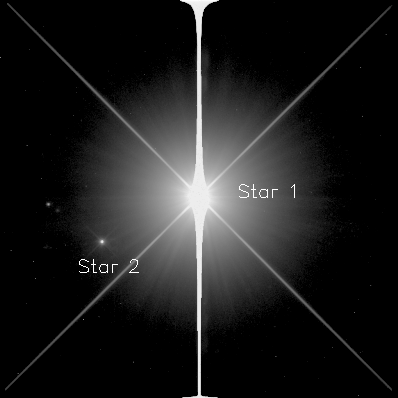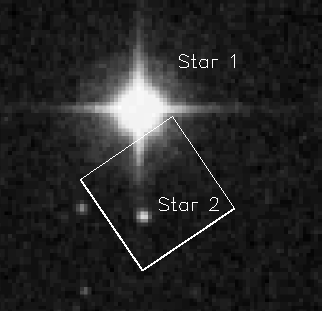
| Bad Astronomy |
|
|
|
BA Blog
|
|
Q & BA
|
|
Bulletin Board
|
| Media |
|
|
|
Bitesize Astronomy
|
|
Bad Astro Store
|
|
Mad Science
|
|
Fun Stuff
|
| Site Info |
|
|
|
Links
|
| RELATED SITES |
| - Universe Today |
| - APOD |
| - The Nine Planets |
| - Mystery Investigators |
| - Slacker Astronomy |
| - Skepticality |
Buy My Stuff

Keep Bad Astronomy close to your heart, and help make me
filthy rich. Hey, it's either this or one of those really
irritating PayPal donation buttons here.
Proper Motion
Week of March 1, 1999On occasion, I will take a few weeks to explore a theme in astronomy on these pages. In 1997 that theme was the solar system. This time, for the next few weeks, I invite you to take a look at the Universe In Motion.
We think of the skies as static, unchanging. The only motions we see easily are the rising and setting of the Sun, Moon and stars, but that is a reflection of our own Earth's rotation. The stars themselves don't seem to move at all among themselves, and it takes a keen eye to discern the motion of the planets, which takes days or weeks to become obvious.
Yet objects in the sky are in constant motion, and some move with an incredible intrinsic velocity. Usually, these objects are so far away that the distance itself shrinks the apparent motion, the way distant mountains hardly seem to move at all even though you may be driving past them at 100 kilometers an hour. Sometimes it does take many years to perceive the movement of heavenly bodies, and sometimes it happens in the blink of an eye. Every Monday, we'll take a look at some of these celestial travelers.
Last week, I promised that this week's Snack would be peculiar. I should have mentioned that it will also be proper! How can that be?
It can be because I am making a horrible pun. Two actually. Last week, I talked about how stars are not fixed on the sky, but can appear to move because the Earth is orbiting the Sun. That's only half the story, though. All stars that we can see with the naked eye are part of the Milky Way galaxy, a large spiral shaped disk comprised of hundreds of billions of stars. The Galaxy is about a hundred thousand light years across, but in most cases the stars we see are actually much closer than that. Sirius, the brightest star in the nighttime sky, is less than ten light years away!
The Galaxy, like the solar system, spins. All stars orbit the center; some on stately circular paths that stay very near the plane of the disk, and others in highly elliptical orbits that take them high above the plane. Unlike the solar system, however, these orbits take a long time to complete: the Sun, for example, takes about 200 million years to circle the Galaxy once. It's only orbited the Galaxy 20 or so times since its birth!
Even though that's a huge length of time, stars cover a lot of ground orbiting the Galaxy. Due to its distance from the center, the Sun moves about 200,000 light years in one circuit. That means it moves about 200 kilometers per second in its long trip. Some stars near the Sun move slower than that, and some faster. So, like cars on a highway, stars continually pass each other as they orbit the Galaxy. They change positions, slowly, but measurably. That means that if we are careful, we can track that change on the sky. The actual motion of the star across the sky is called proper motion, to distinguish it from motion measured using the Doppler shift (which will be the topic of next week's Snack!). It helps astronomers in some ways to think of stars orbiting the Galaxy in groups, and then thinking of each star's motion as a deviation from that group motion. In that case, a given star's motion is called peculiar motion, as in a characteristic peculiar to a given object.
The proper motions of stars is measured in the distance they move across the sky per year. It's usually quite small, and measured in arcseconds per year (the Full Moon is 1800 arcseconds across, for comparison). The star with the largest proper motion is an unassuming dwarf, invisible to the naked eye, named Barnard's Star after its discoverer. It moves about 10 arcseconds per year. But what does this look like, really?

 While doing some routine
data analysis for for my work with STIS
data, I ran across a star that had me baffled. The STIS image is shown
on the left (click on it to see the full size version). The star (labeled
``Star 1'') is so bright it overflowed STIS' detector, which is why there
is a thick vertical line of light. The diagonal lines are an artifact of
the way Hubble is built, and you can ignore them. Note that there is a much
fainter star (labeled ``Star 2'') just to the left of the very bright one.
While doing some routine
data analysis for for my work with STIS
data, I ran across a star that had me baffled. The STIS image is shown
on the left (click on it to see the full size version). The star (labeled
``Star 1'') is so bright it overflowed STIS' detector, which is why there
is a thick vertical line of light. The diagonal lines are an artifact of
the way Hubble is built, and you can ignore them. Note that there is a much
fainter star (labeled ``Star 2'') just to the left of the very bright one.
Now, that STIS image is pretty small on the sky, and I wanted to know what stars were nearby. I downloaded an image of the surrounding area and plotted where STIS was looking when the observation was made. That image is shown on the right (click on it to see the full size version), and is about three or four times the area of the STIS image on the sky. The square plotted represents where STIS was looking when the left hand image was taken, and the two thick lines are the left side and bottom of the STIS field (tilt your head if it helps!). I also labeled the stars the same way as in the STIS image. Again, the crosshairs effect is an artifact of the way the second image was taken, so you can ignore them too.
In that second image, you can see that the faint star is in about the right place, but the bright star is not even in STIS's field! This caused me a lot of consternation until I realized what was going on: the image on the right was taken in 1983, and between then and 1999, when the STIS image was taken, the star had physically moved across the sky. It moved over half of STIS's field of view, so when the astronomers took the STIS image, they had to account for that proper motion. Clearly, they did a great job: the star is centered almost perfectly in the STIS image. The star's actual motion is only a few arcseconds per year. That may not sound like much; it would take hundreds of years for the star to move across the apparent size of the Moon. However, when you are dealing with such precise instruments as STIS and Hubble, even small changes count!
|
|
| THE PANTRY: ARCHIVE OF BITESIZE SNACKS |
|
|
| Subscribe to the Bad Astronomy Newsletter! |
| Talk about Bad Astronomy on the BA Bulletin Board! |